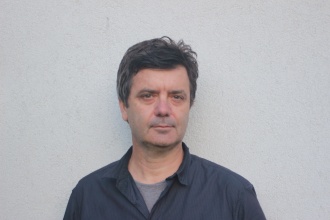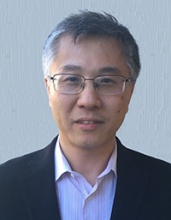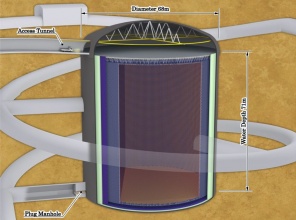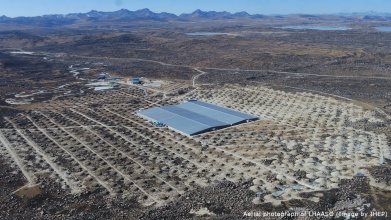News
-
Published on
Professor Federico Sanchez re-elected as International Co-spokesperson of the T2K Experiment
Congratulations to Professor Federico Sanchez from the DPNC (Particle Physics Department) who has been re-elected for a second t…

-
Published on
Nomination au titre de Professeur Ordinaire de Xin WU au DPNC
Le professeur Xin Wu est passé du titre de Professeur Titulaire à celui de Professeur Ordinaire en mars 2021

-
Published on
The groundbreaking ceremony for the Hyper-Kamiokande
The groundbreaking ceremony for the Hyper-Kamiokande, a new world-leading international scientific research project which is set…

-
Published on
LHAASO Discovers a Dozen PeVatrons and Photons Exceeding 1 PeV and Launches Ultra-High-Energy Gamma Astronomy Era
The DPNC Astroparticle group, led by Prof Montaruli and composed by the MER Dr. della Volpe and CS Dr Heller, has contribute to…

Archives
-
2022
-
June
- Making (gravitational) waves in Switzerland In Switzerland, gravitational waves go a long way. Not only were they predicted by Albert Einstein in his famous general theory of relativity; Swiss researchers have been involved in attempts to detect gravitational waves from the very beginning and are keen to lend their expertise, including from particle physics, to future projects as well. Here’s an update about the current state of research…
- Making (gravitational) waves in Switzerland
-
February
-
January
- The first version of the SFGDreadout board The first version of the SFGDreadout board arrived in our lab. The new board is a highly complex design done by a collaboration from the LLR (Ecole Polytechnique in France) and the DPNC (Universite de Geneve). The board is capable of reading 256 Silicon PhotoMultipliers using the CITIROC chip in a very compact multilayer design. The electronic card also provides the HV bias voltage and reads the signal from the Silicon PMT's providing a quasi dead-time-free readout in an almost autonomous setup. The boards will be tested by a team from both institutions before launching the full production in September 2022.
- The first version of the SFGDreadout board
-
-
2021
-
August
-
June
- Professor Federico Sanchez re-elected as International Co-spokesperson of the T2K Experiment Congratulations to Professor Federico Sanchez from the DPNC (Particle Physics Department) who has been re-elected for a second term as International Co-spokesperson of the International collaboration T2K
- Nomination au titre de Professeur Ordinaire de Xin WU au DPNC Le professeur Xin Wu est passé du titre de Professeur Titulaire à celui de Professeur Ordinaire en mars 2021
- Professor Federico Sanchez re-elected as International Co-spokesperson of the T2K Experiment
-
May
- The groundbreaking ceremony for the Hyper-Kamiokande The groundbreaking ceremony for the Hyper-Kamiokande, a new world-leading international scientific research project which is set to start experiments in 2027, was held at its construction site in Hida City, Gifu Prefecture, Japan on May 28, 2021.
- LHAASO Discovers a Dozen PeVatrons and Photons Exceeding 1 PeV and Launches Ultra-High-Energy Gamma Astronomy Era The DPNC Astroparticle group, led by Prof Montaruli and composed by the MER Dr. della Volpe and CS Dr Heller, has contribute to the LHAASO experiment by providing the technology Cherenkov Telescope photodetection plane.
- The groundbreaking ceremony for the Hyper-Kamiokande
-
April
- New AMS results on heavy secondary fluorine nuclei show that cosmic rays don't all propagate the same way The Alpha Magnetic Spectrometer (AMS), steadily acquiring cosmic-ray data on the International Space Station (ISS) since May 2011, has measured with percent-level accuracy the spectrum of fluorine nuclei in cosmic rays, providing for the first time the characterization of heavy secondary cosmic-ray spectrum, that is their intensity as function of energy.
- New AMS results on heavy secondary fluorine nuclei show that cosmic rays don't all propagate the same way
-
February
- T2K results on CP violation selected among the top 10 scientific results of 2020 by Nature T2K published in March 2020 the first indication of possible violation of the symmetry between neutrinos and antineutrinos in oscillations.
- Latest results from AMS bring a new puzzle on the heaviest side of cosmic rays The Alpha Magnetic Spectrometer (AMS) installed on the International Space Station since May 2011 has measured with percent-level accuracy the spectrum of iron nuclei in cosmic rays, providing for the first time the characterization of these very heavy cosmic-ray component.
- T2K results on CP violation selected among the top 10 scientific results of 2020 by Nature
-
-
2020
-
December
- Dr. Steven Schramm awarded an SNF Eccellenza Professorial Fellowship Dr. Steven Schramm of the Department of Nuclear and Corpuscular Physics (DPNC) has obtained an SNF Eccellenza Professorial Fellowship in support of his project titled “Turning noise into data: a discovery strategy for new weakly-interacting physics.”
- Dr. Steven Schramm awarded an SNF Eccellenza Professorial Fellowship
-
October
- Dr. Steven Schramm awarded an ERC Starting Grant Dr. Steven Schramm of the Department of Nuclear and Corpuscular Physics (DPNC) has obtained an ERC Starting Grant providing funding of up to € 1.5 million over five years, for the DISCOVERHEP project (Turning noise into data: a discovery strategy for new weakly-interacting physics).
- Dr. Steven Schramm awarded an ERC Starting Grant
-
June
- The first CTA Large Size Telescope Detects Very High-Energy Emission from the Crab Pulsar La Palma, Canary Islands, Spain – Between January and February 2020, the prototype Large-Sized Telescope (LST), the LST-1, observed the Crab Pulsar, the neutron star at the centre of the Crab Nebula. The telescope, which is being commissioned on the CTA-North site on the island of La Palma in the Canary Islands, was conducting engineering runs to verify the telescope performance and adjust operating parameters.
- The first CTA Large Size Telescope Detects Very High-Energy Emission from the Crab Pulsar
-
February
-
-
2019
-
September
-
May
-
April
- Thèse en 180 secondes - Dalila Salamani Mme Dalila Salamani, Doctorante au DPNC a reçu le 2ème prix du Jury.
- Thèse en 180 secondes - Dalila Salamani
-
March
- FASER: CERN approves new experiment to look for long-lived, exotic particles The experiment, which will complement existing searches for dark matter at the LHC, will be operational in 2021
- FASER: CERN approves new experiment to look for long-lived, exotic particles
-
January
- Universe: the orderly chaos of black holes Researchers at UNIGE have discovered that photons emitted during the creation of a black hole appear to be disordered. Within a single time slice they however appear to be highly ordered.
- Universe: the orderly chaos of black holes
-
-
2018
-
September
- Can’t Stop These Japanese Neutrinos ! Hyper-Kamiokande Experiment to Begin Construction in April 2020
- Phase 2 of the tracking machine learning challenge has started The second phase of the TrackML tracking machine learning challenge has just started and you are invited to participate and contribute.
- Can’t Stop These Japanese Neutrinos !
-
July
- IceCube results Exciting news about #IceCubeNeutrinos and #MultimessengerAstronomy!
- IceCube results
-
June
- Nuit De La Science 2018 Le DPNC participe à la Nuit de la Science. Expérimentons-nous avec la physique des particules !
- ATLAS produces the first measurement of Higgs production in association with top quarks The ATLAS and CMS experiments at the Large Hadron Collider at CERN have independently observed the production of Higgs bosons in association with two top quarks. The results presented this week at the LHCP conference in Bologna allow for the first time a direct determination of the couplings between top quarks and the Higgs boson. Dr. Stefan Gadatsch from the ATLAS group of Prof. Tobias Golling here at DPNC was one the leaders of the analysis and an editor of the paper.
- Nuit De La Science 2018
-
February
- Baby MIND detector completed On Feb 16 2018, we completed the heavy installation work for the Baby MIND detector, which is now in its place as it was always meant to be, downstream of WAGASCI. Many thanks to all involved in making this happen. Best regards, Etam on behalf of the installation team pictured in the photo (credit Marat).
- Baby MIND detector completed
-
-
2017
-
December
- Neutrinos from Nowhere Thanks to the University of Geneva Swiss astroparticle physics participates in IceCube - a huge experiment in neutrino research at the South Pole. The scientists aim to probe with IceCube the exact origin of the neutrinos coming from the universe. For over two years the young scientist Tessa Carver (24) has been part of the experiment.
- Un «chasseur de matière noire» décortique les rayons cosmiques Co-dirigée par l’Université de Genève, la mission DAMPE, chargée de détecter de la matière noire dans l’Univers, fait part de ses premiers résultats scientifques. Jamais détectée, la matière noire est pourtant considérée comme un élément important pour la compréhension et l’étude de nombreux phénomènes dans l’Univers. La mission DAMPE (DArk Matter Particle Explorer), initiée en 2012 par l’Académie des Sciences Chinoises (CAS) en collaboration avec l’Université de Genève (UNIGE) et l’Institut National de Physique Nucléaire d’Italie (INFN), s’est donné pour mission d’en découvrir la trace ; ses premiers résultats scientifques sont publiés aujourd’hui dans la revue Nature. Les données collectées par le satellite révèlent la distribution des particules des rayons cosmiques selon leur énergie : plus l’énergie mesurée est basse, plus les particules sont nombreuses, et inversement. Mais ce qui devait être une courbe régulière présente en réalité une cassure inexpliquée dans le domaine des hautes énergies, autour de 0.9 TeV, à partir duquel les particules sont moins nombreuses qu’attendu. Comprendre cette «rupture de spectre» pourrait nous permettre de remonter jusqu’à la source qui a émis ces particules. Et parmi les sources candidates, l’annihilation ou la désintégration de matière noire.
- Neutrinos from Nowhere
-
October
- LIGO and Virgo detects gravitational waves from colliding neutron stars
- No neutrino emission from a binary neutron star merger
- The Nobel Prize in Physics 2017 On 14 September 2015, the universe's gravitational waves were observed for the very first time.
- LIGO and Virgo detects gravitational waves from colliding neutron stars
-
September
-
March
- « Particle Physics – an Introduction » The MOOC « Particle Physics – an Introduction » is now available in French as well as in English. This course introduces you to subatomic physics, i.e. the physics of nuclei and particles.
- « Particle Physics – an Introduction »
-
